MIST
Magnetosphere, Ionosphere and Solar-Terrestrial
Nuggets of MIST science, summarising recent papers from the UK MIST community in a bitesize format.
If you would like to submit a nugget, please fill in the following form: https://forms.gle/Pn3mL73kHLn4VEZ66 and we will arrange a slot for you in the schedule. Nuggets should be 100–300 words long and include a figure/animation. Please get in touch!
If you have any issues with the form, please contact This email address is being protected from spambots. You need JavaScript enabled to view it..
Simultaneous Observation of an Auroral Dawn Storm with the Hubble Space Telescope and Juno
By Ben Swithenbank-Harris (University of Leicester)
Jupiter’s dawn storms are bright enhancements of the dawn flank of the main auroral emission, and produce the most powerful auroral events in the Solar System. These events have been observed numerous times with the Hubble Space Telescope (HST), and more recently by the Juno spacecraft, but their exact origins and related magnetospheric dynamics are not fully understood. For example, although consistent observations of this phenomena near local dawn suggested a relationship with the impinging solar wind, previous studies have shown no correlation between storm occurrence and solar wind conditions. Additionally, prior to the arrival of the Juno spacecraft at Jupiter in July 2016, auroral observations of dawn storms had not been supported by magnetospheric data from spacecraft in the dawn magnetosphere.
In this work, we present the first simultaneous magnetospheric in situ and auroral observations of the onset of a dawn storm. Magnetometer readings reveal brief reversals in the azimuthal magnetic field and decreases in the radial and total field magnitudes around the time of storm onset (Figure 1a-d). Furthermore, concurrent JADE (Figure 1e-h) and JEDI (Figure 1k-n) particle measurements reveal an increase in high energy particle populations and acceleration of magnetospheric protons towards corotational speeds, as well as long-lived hot plasma populations which persist in the outer magnetosphere beyond the expected lifetime of the enhanced auroral emissions. Ultimately, we associate this dawn storm with significant plasma heating and acceleration following reconnection at earlier local times.
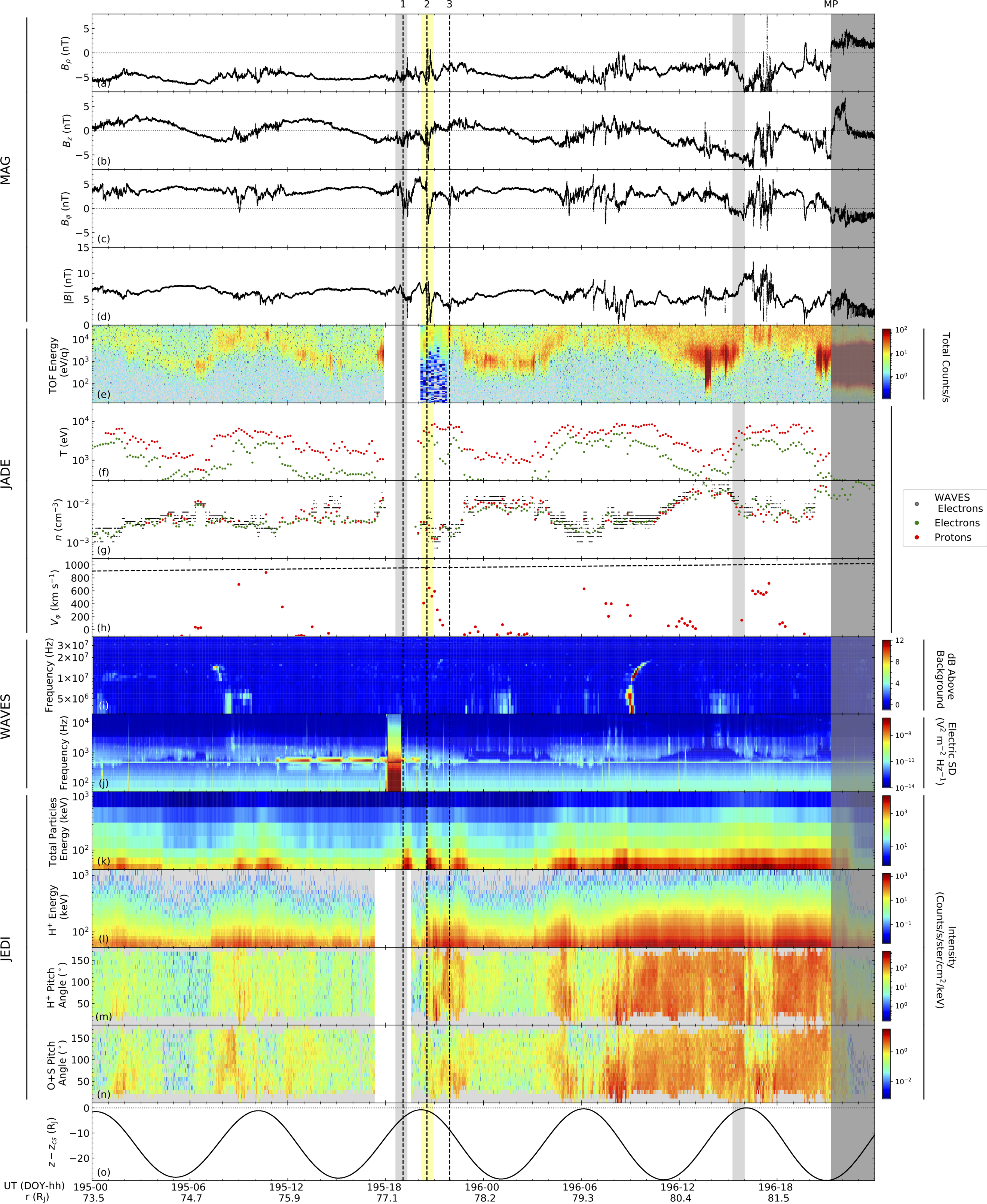
Figure 1: Overview of the Juno in situ data, showing (1a-d) the radial, north-south, azimuthal and total magnetic field strength (nT) in cylindrical polar coordinates, (1e-h) the JADE ion time-of-flight energy spectra, electron and proton temperatures (K), number densities (cm-3) and proton azimuthal velocities (km s-1), (1i-j) Waves high frequency and electric field continuum emissions, (1k-n) JEDI particle spectra showing the total particle and proton energies (k-l) and the proton and heavy ion pitch angle distributions (m-n), (1o) and the expected spacecraft distance from the centre of the current sheet (RJ), calculated using the method of Khurana (1992). The light grey shaded regions show the times of HST observations, with the dawn storm interval denoted by the yellow shaded region. The darker grey shading denotes a magnetopause crossing, and the three dotted vertical lines mark the times of several successive reversals in the azimuthal magnetic field.
Please see the paper for full details:
Swithenbank‐Harris, B.G., Nichols, J.D., Allegrini, F., Bagenal, F., Bonfond, B., Bunce, E.J., et al. (2021). Simultaneous Observation of an Auroral Dawn Storm with the Hubble Space Telescope and Juno. Journal of Geophysical Research: Space Physics, 126, e2020JA028717. https://doi.org/10.1029/2020JA028717
Pro‐L* ‐ A probabilistic L* mapping tool for ground observations
By Rhys Thompson (University of Reading)
Both ground and space observations are used extensively in the modeling of space weather processes within the Earth's magnetosphere. The shape of the magnetic field is not fixed, however, and there is not a consistent relationship between the footprint location of a ground measurement and its respective position in space. With no way to validate the global true magnetic field, numerous models exist to approximate it, allowing a subset of locations on the ground (mainly sub‐auroral) to be mapped along field lines to a location in space.
We often envision the radiation belts in a fixed coordinate system representative of the motions of the trapped particles. Often considered a proxy for distance is L*, a quantity related to the radial motion of electrons. Once an observation's respective location in the magnetic field is approximated it can be transformed into L*, provided the electrons at the measurement's physical location remain trapped by the Earth’s magnetic field.
Dependency of L* on magnetic field model accuracy is therefore paramount, however these models can significantly disagree on mapped L* values for a single point on the ground, during both quiet times and storms.
We present a state‐of‐the‐art tool, Pro‐L*, which for any ground observation provides the probabilities of corresponding L* values. Usage is highlighted for both event studies (a simple demonstration can be seen in Figure 1) and statistical models, and we demonstrate a number of potential applications. Pro-L* may be accessed as a freely available Python package at https://github.com/Rhyst223/pro-lstar.git.
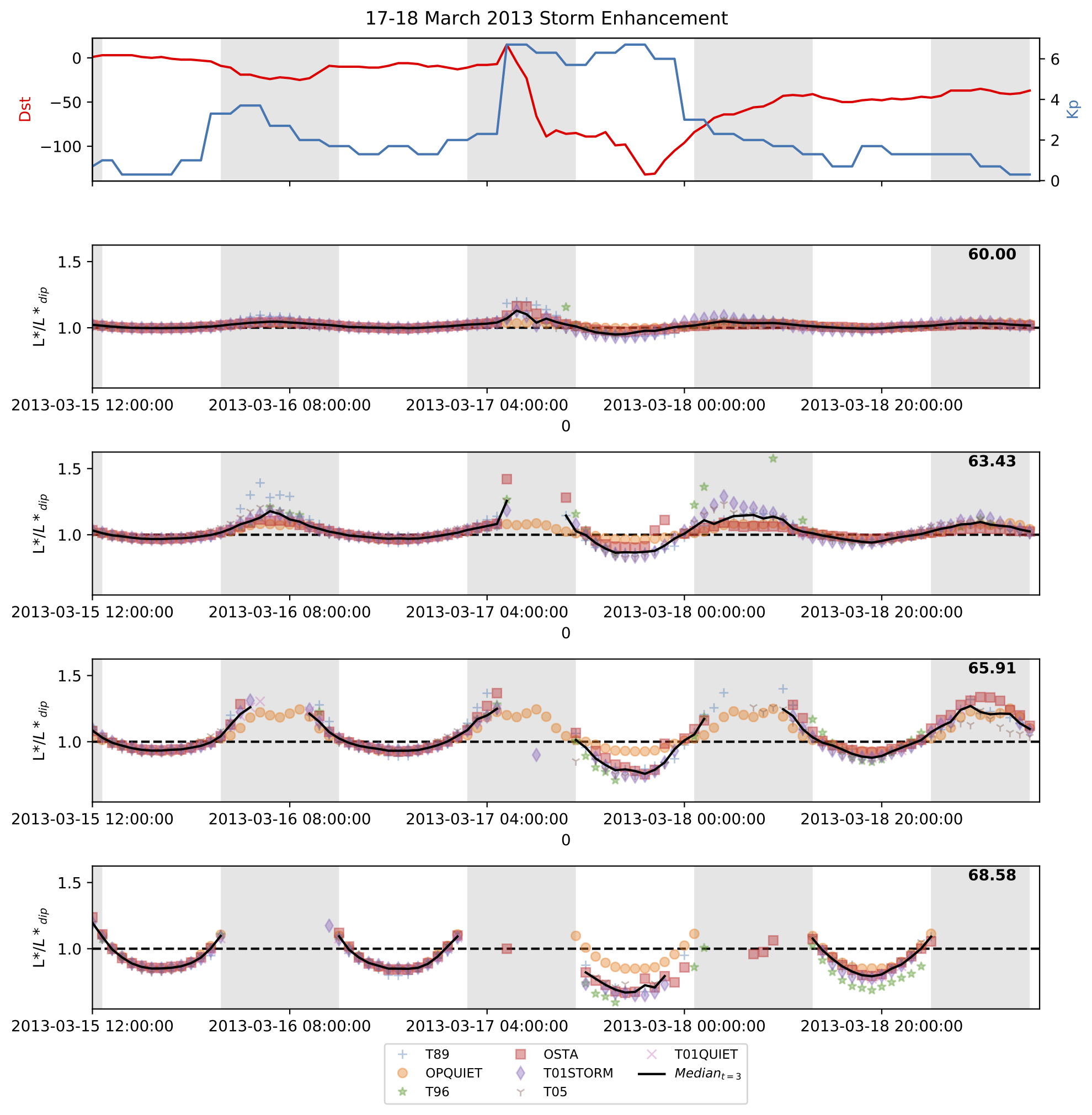
Figure 1: The L* response of magnetic field models to the 17-18 March 2013 storm enhancement, for a selection of magnetic latitudes at 330 degrees magnetic longitude, where ground observations are frequently of interest. The median probabilistic L* is also given provided that at least 3 magnetic field models return an L* value. All returned L* are normalised by their respective constant dipole approximation for comparison of latitudes on the same scale. The Dst and Kp indices are also provided over the given time period. Shaded bars indicate times where observed values are on the nightside.
Please see the paper for full details:
Thompson, R. L., Morley, S. K., Watt, C. E. J., Bentley, S. N., & Williams, P. D. (2020). Pro‐L* ‐ A probabilistic L* mapping tool for ground observations. Space Weather, 18, e2020SW002602. https://doi.org/10.1029/2020SW002602
Comparative Analysis of the Various Generalized Ohm’s Law Terms in Magnetosheath Turbulence as Observed by Magnetospheric Multiscale
By Julia E. Stawarz (Imperial College London)
Complex, highly nonlinear, turbulent dynamics play an important role in particle acceleration and plasma heating throughout the Universe by transferring energy from large-scale to small-scale fluctuations that can be more easily dissipated. Electric fields (E) in these plasmas are responsible for mediating energy exchange between the magnetic fields and particle motions and, therefore, can provide key insight into both the nonlinear dynamics of the turbulence and the processes responsible for dissipating the fluctuations. In the collisionless plasmas often found in space, E is described by generalized Ohm’s law, displayed in Fig. 1.
In Stawarz et al. (2021), we directly measure nearly all the terms in generalized Ohm’s law for several intervals in Earth’s magnetosheath and, for the first time, examine how Ohm’s law shapes the turbulent E at different length scales. Many terms in Ohm’s law, require the computation of small-scale gradients, and, therefore, the unique high-resolution, multi-spacecraft measurements from NASA’s Magnetospheric Multiscale mission were necessary to perform the study. As seen in Fig. 1, we find that, at scales larger than the proton inertial length, the observed E is given by the ideal magnetohydrodynamic term, while, at sub-proton scales, a combination of the Hall and electron pressure terms control E, as expected. Other terms, related to the difference between proton and electron inertia and the finite mass of electrons, remain small across the observable scales. Within the paper, we explore the interplay of the various terms in further detail by examining the correlation between the Hall and electron pressure terms, which provides insight into the types of sub-proton-scale structures formed, and by exploring the relative contribution of linear and nonlinear terms in Ohm’s law at different scales.
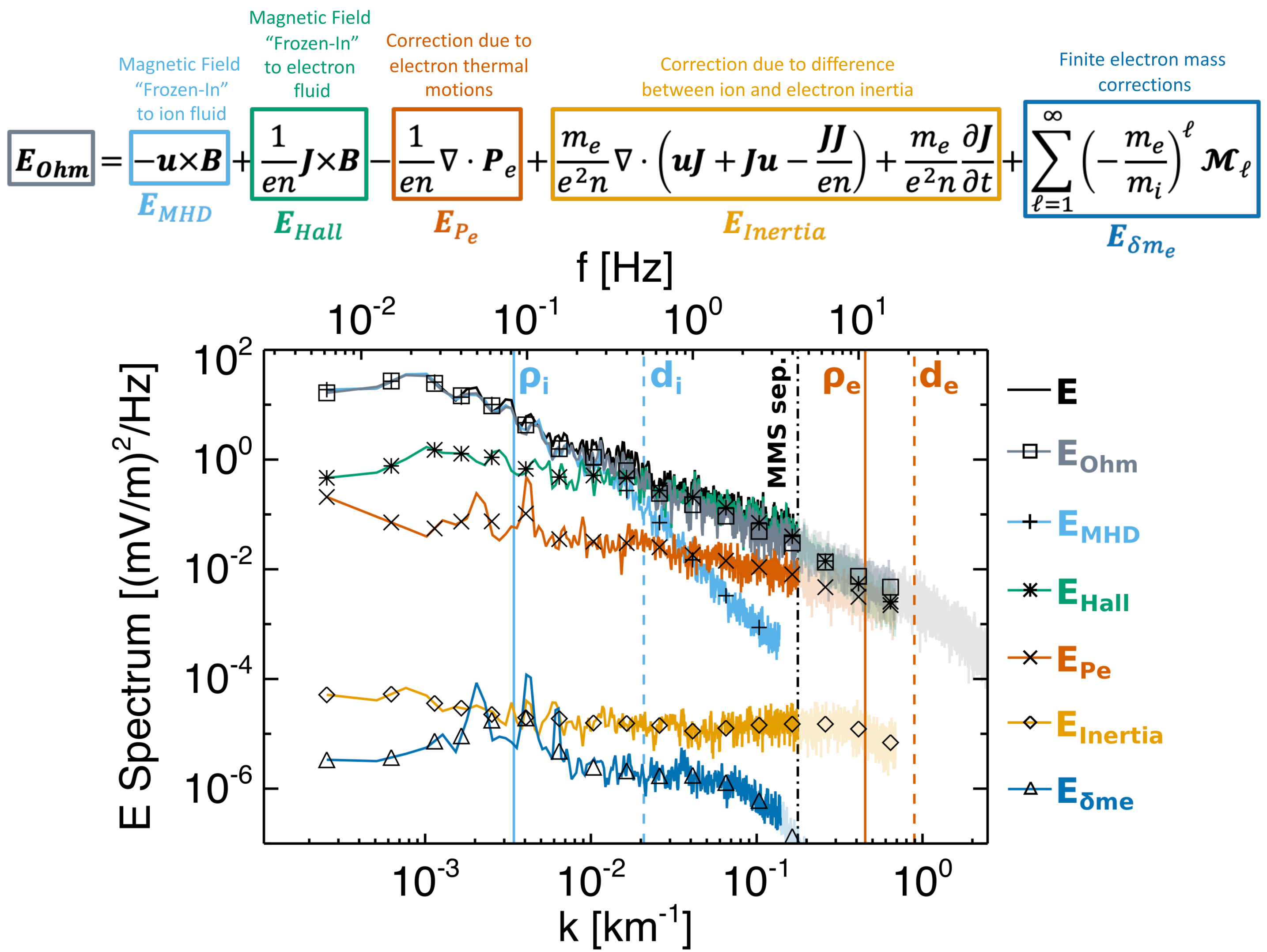
Fig.1: (Top) Generalized Ohm’s law for a collisionless, two species plasma, highlighting the different dynamical effects that can support E. (Bottom) Spectra of the terms in Ohm’s law and the observed E for an interval of turbulence in Earth’s magnetosheath. Vertical lines denote the proton and electron gyroradii (ρi/e), inertial lengths (di/e), and spacecraft formation size.
Please see the paper for full details:
J. E. Stawarz, L. Matteini, T. N. Parashar, L. Franci, J. P. Eastwood, C. A. Gonzalez, I. L. Gingell, J. L. Burch, R. E. Ergun, N. Ahmadi, B. L. Giles, D. J. Gershman, O. Le Contel, P.-A. Lindqvist, C. T. Russell, R. J. Strangeway, and R. B. Torbert (2021). Comparative Analysis of the Various Generalized Ohm’s Law Terms in Magnetosheath Turbulence as Observed by Magnetospheric Multiscale. J. Geophys. Res., 126, e2020JA028447, doi:10.1029/2020JA028447.
Design and Optimization of a High-Time-Resolution Magnetic Plasma Analyzer (MPA)
By Benjamin Criton (Mullard Space Science Laboratory, UCL)
Cutting-edge solar wind investigations require in-situ instruments with increasing time and energy resolution to study the important small-scale plasma processes. These processes play key roles in the overall behaviour of space plasmas. They are believed to be the origin of the heating and acceleration of the solar wind. Unfortunately, these processes happen on very short timescales. To measure them, virtually all flown plasma analyzers use an approach to select particle energies, achieved by an electric field. Faraday cups use a high-pass energy selection whilst electrostatic analysers (ESAs) a band-pass selection. This functioning requires to sweep the energy range to build the entire energy spectrum of the measured plasma. Even though Faraday cups are comparatively faster than ESAs, these two instrument categories make relatively slow measurements: 4 s for Cluster HIA, 1 s for Solar Orbiter PAS or 0.22 s for Parker Solar Probe SPC.
In this article, we conceptualize and design a plasma analyzer answering this rising demand for high time and energy resolution. Our new design, based on the velocity-dependent deflection of charged particles in a homogeneous magnetic field, does not require any time-dependent energy selection, making measurements much faster and reliable compared to traditional analyzers. Particles hit a position-sensitive sensor at different positions according to their velocity and mass-per-charge ratio. In one acquisition step, each incoming charged plasma particle is detected at a specific position in the sensor plane. We then translate the counts per position into an estimation of the velocity distribution function (VDF). Our study shows that this measurement principle achieves a 1D measurement of proton and alpha-particle VDFs under realistic solar wind conditions in 5 ms (200 Hz) with a velocity resolution of 2.8 %. This time cadence is two orders of magnitudes faster than the sampling frequency required to measure processes of order the proton gyro-radius at a heliocentric distance of 1 au and about 40 times faster than Parker Solar Probe SPC’s native cadence. Furthermore, the velocity/energy resolution only depends on the physical instrument parameters (aperture size, pixel size and magnetic field strength) that can be adjusted to best address the trade-off between time and energy resolution.
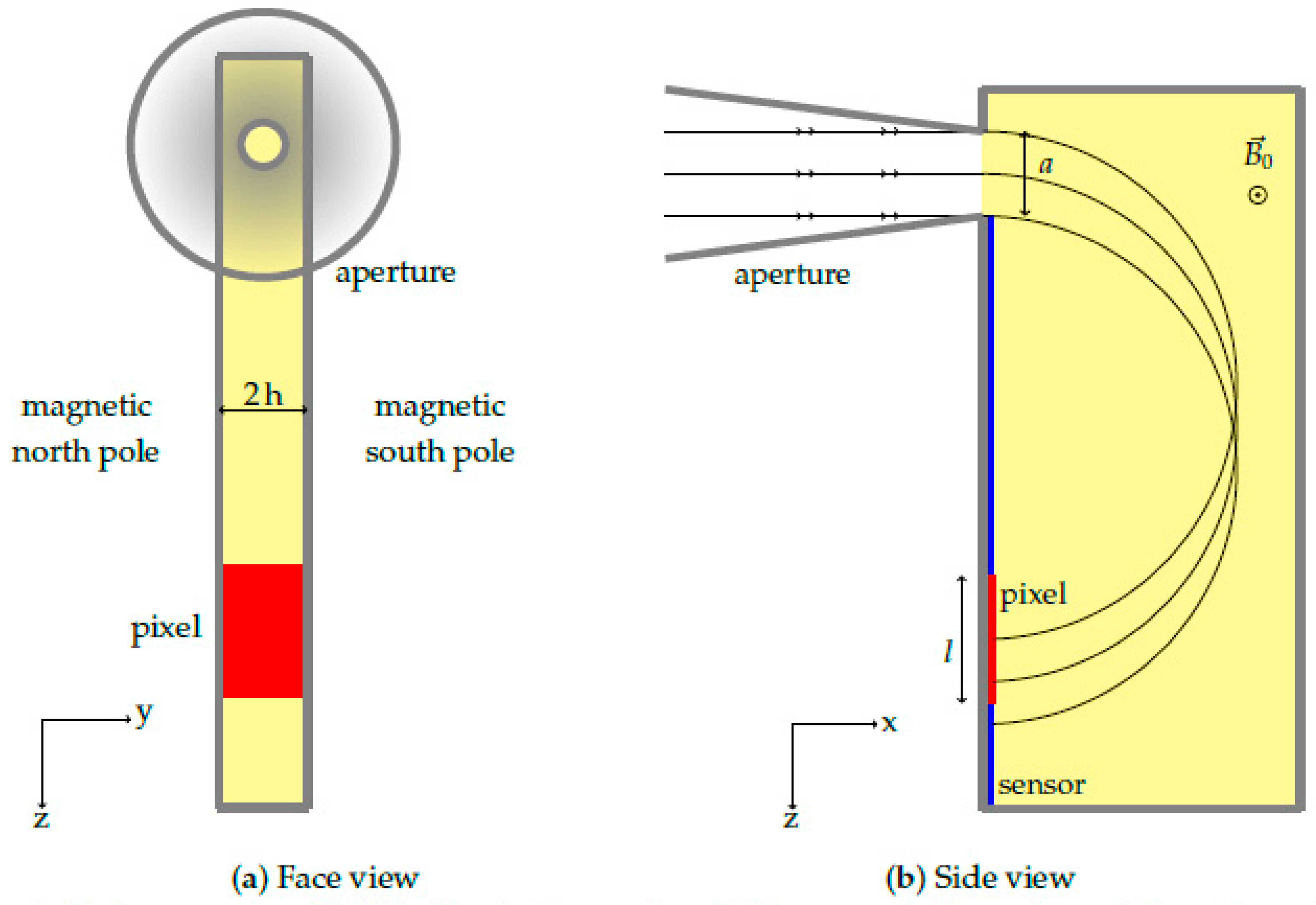
Fig. 1 shows the conceptual geometry of the instrument. This new instrument concept is able to unveil the fast variations of the ion VDFs in one look direction.
Please see the paper for full details:
Criton B, Nicolaou G, Verscharen D. (2020). Design and Optimization of a High-Time-Resolution Magnetic Plasma Analyzer (MPA). Applied Sciences. 10(23):8483. https://doi.org/10.3390/app10238483
Evaluating the performance of a plasma analyzer for a space weather monitor mission concept
By Georgios Nicolaou (Mullard Space Science Laboratory/UCL; Southwest Research Institute)
Georgios Nicolaou et al. developed a forward model of an electrostatic analyzer response which simulates observations of solar wind protons with their velocities following the classic Maxwell distribution function. This paper studies the observations of extreme space weather features such as, fast ICMEs and fast solar wind streams, but also the observations of a typical background solar wind. The model takes into account the limited sampling and resolution of the instrument. The analysis of the modeled observations derives the plasma parameters from the statistical moments of the observed velocity distribution functions. This is a classic novel analysis method, which is appropriate for space weather missions as it can be applied onboard spacecraft and predict the solar wind plasma bulk parameters very fast, reducing the required telemetry and computational resources. The comparison between the analysis results and the input parameters identifies the accuracy of the specific method applied to the observations by the instrument. The authors address the limitation of the moments analysis and demonstrate how we can overcome these limitations by fitting the observations with distribution function models. The fitting analysis is demonstrated in observations of fast ICMEs (see Figure 1) and fast solar wind streams identified in ACE observations.
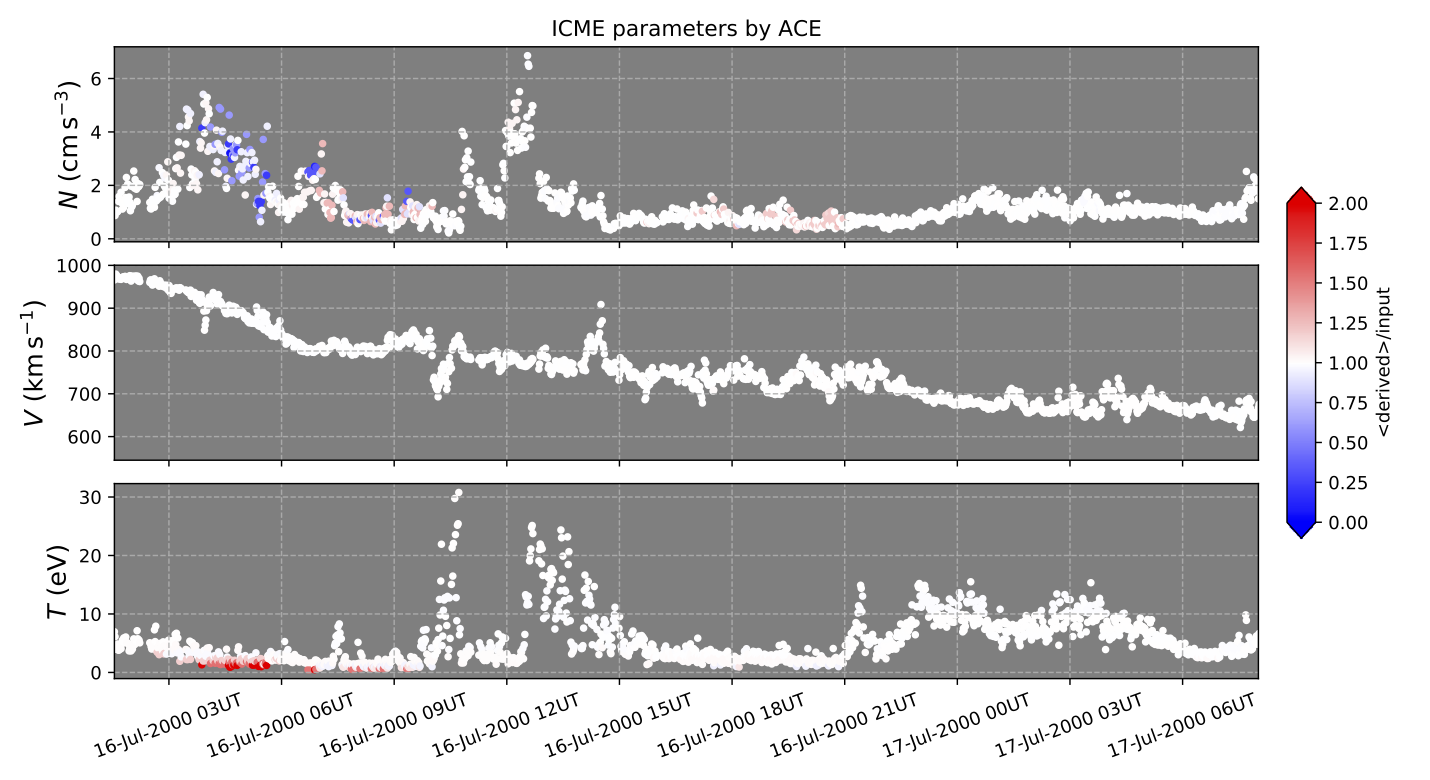
Figure 1. Time series of (top) the plasma density, (middle) bulk speed, and (bottom) scalar temperature within a fast ICME recorded by ACE from 16 July 2000 01:00 to 17 July 2000 08:00. The color represents the accuracy with which the fitting analysis of the observations by our instrument derives the corresponding parameters.
Please see the paper for full details:
, , , & (2020). Evaluating the performance of a plasma analyzer for a space weather monitor mission concept. Space Weather, 18, e2020SW002559. Accepted Author Manuscript. https://doi.org/10.1029/2020SW002559